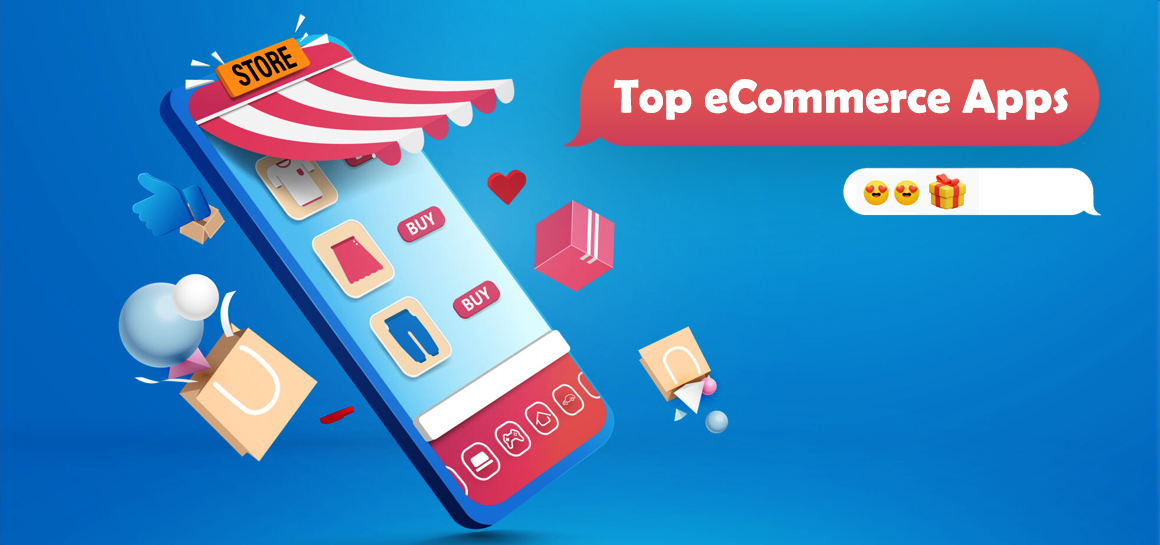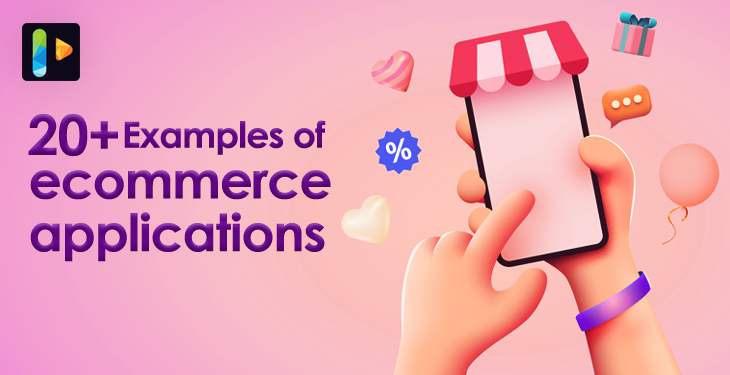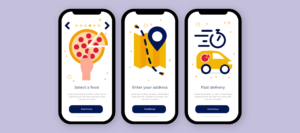In today’s consumers, the mobile phone is still the most favored device for purchasing journeys even though they study on many displays and make purchases on the go: While PC usage is declining, the number of mobile transactions keeps increasing.
eCommerce apps are now crucial to the success of any business. Business owners switched from physical storefronts to digital solutions to sell online during the epidemic, which helped them improve their customer base and revenue by 55%. 53.9% of all e-commerce sales worldwide were made through mobile devices by 2021 and ecommerce application developed on many technology it could be on android app development , iOS app Development etc.
Businesses of all sizes are enhancing their on-the-go experience with ecommerce applications as more consumers use their smartphones to purchase anywhere. Let’s look at a few examples of ecommerce applications that have ruled mobile commerce.
| Application | Launched | Platforms | Revenew |
| Shopify | 2006 | Android, iOS | $1.295B |
| Amazon | 1994 | Android, iOS | $121.2 billion |
| Flipkart | 2007 | Android, iOS | Rs 44 crore |
| eBay | 1995 | Android, iOS | $10.019B |
| WooCommerce | 2011 | Android, iOS | $1.1B |
| Upwork | 2013 | Android, iOS | $151 million |
| Olx | 2006 | Android, iOS | $50 million |
| Quikr | 2008 | Android, iOS | Rs 61 Crore |
| Urbanic | 2018 | Android, iOS | $30.3M per year |
| Myntra | 2007 | Android, iOS | Rs 2,466.6 crore |
| Warby Parker | 2010 | iOS | $149.6 million |
| Nike | 1964 | Android, iOS | $46.71 billion |
| H&M | 1947 | Android, iOS | $471 million |
| Shiprocket | 2017 | Android, iOS | $27 million |
| Wayfair | 2011 | Android, iOS | $12.6 billion |
| Wish | 2011 | Android, iOS | $54 million |
| Dollar Shave Club | 2011 | Android, iOS | $50 million |
| Lenskart | 2010 | Android, iOS | Rs 29 crore |
| Goat | 2015 | iOS | $57 million |
| Walmart | 1962 | Android, iOS | 2.3 million |
Top eCommerce Apps:

1. Shopify:
Shopify is an example of ecommerce applications that allows anyone to create a virtual storefront. Additionally, it provides other goods and services like fulfillment or POS systems.
Shopify generates revenue by selling hardware, commissions from its app, theme, and Exchange marketplace, domain name sales, email marketing, investments, and logistical services. It also generates revenue from transaction and referral fees.
In 2006, Scott Lake, Daniel Weinand, and Tobias Lutke established the business. Its headquarters are in Ottawa, Canada. Shopify has grown to be a massive company with a presence in 175 countries, $4.6 billion in revenue in FY21, and $54 billion in GMV in Q4 of 2021.
2. Amazon:
The largest online retailer in the world, Amazon.com Inc. (AMZN), has experienced tremendous growth in various industries, including cloud services, digital advertising, and its core e commerce activities. Among other things, Amazon generates revenue through its web services, subscriptions, and retail businesses.
Retail continues to be Amazon’s largest income source, with online and offline stores making up the majority of this stream. Amazon Web Services (AWS) is responsible for all of the company’s operating profits and is expanding quickly. Amazon’s market value was $1.6 trillion as of February 2022.
3. Flipkart:
Flipkart, an e-commerce giant, founded in 2007, currently holds an astonishing 40% of the market share in the Indian e-commerce sector. Sachin and Binny Bansal first conceptualized the Flipkart e-Commerce Company. They are both previous executives for Amazon. The Bansal brothers initially committed $5,600 to create the ultimate online bookstore website. But during the fiscal year 2020–2021 (FY21), Flipkart, owned by Walmart, recorded revenue of Rs. 43,357 crores, a 25% increase over FY20, while its net loss decreased by 23% to Rs. 2,445 crores.
4. eBay:
Since it was among the first e-commerce platforms, eBay continues to rule the online marketplace by enabling commercial enterprises and private consumers to conduct online sales.
As of 2019, eBay is a multibillion-dollar company with operations in around 32 nations. For the quarter ending June 30, 2022, eBay’s revenue was $2.422B, a 9.22% year-over-year decrease.
5. WooCommerce:
You will have a wide range of alternatives while setting up an eCommerce site, but WooCOmmerce is one of the best examples of ecommerce applications.
Compared to other eCommerce platforms, WooCommerce powers over 25% of the top 1 million websites worldwide. These numbers are still rising since it is adaptable and user-friendly. It generates revenue by marketing hundreds of practical platform add-ons or plugin extensions. It’s a great income strategy because they own and run the platform. It allows them to profit from the extensions that company owners use. Depending on the quantity and kind chosen, these extensions might cost anywhere from $50 to $300 annually.
6. Upwork:
A US-based network for freelancers, Upwork was once known as Elance-oDesk. Upwork was created through the merger of Elance and oDesk in 2015, and its official name is now Upwork Global Inc. Santa Clara and San Francisco, California, are the present locations of Upwork. Upwork is undoubtedly creating a name for itself in the world of freelancing with a presence in more than 180 countries and clients from 30% of the 100 Fortune firms.
With a 24% increase from 2019, Upwork’s revenue in 2020 was approximately $373 million. Upwork bases its business model on collecting a fee for each successful job it advertises on its marketplace. The way that Upwork makes money is by charging both clients and independent contractors.
7. Olx:
The most exclusive example of ecommerce application, OLX, allows users to sell anything at a fair price digitally. People become conscientious when buying used goods and do not want to waste their hard-earned cash on unworthy stuff.
Due to its enormous success in emerging regions worldwide, OLX has attracted a lot of attention from investors, who are optimistic that the company would benefit. The company has raised close to $28 million in its fifth investment round. In 2020 and 2021, OLX’s operational revenue was 206 crores and 228 crores, respectively.
8. Quikr:
Quikr is a Bangalore-based online marketplace and classified advertising business in India. There are postings for mobile phones, household products, autos, real estate, jobs, services, and education on Quikr in more than 1000 Indian cities. Jiby Thomas and Pranay Chulet launched it in 2008. Quikr is a free classifieds website and online marketplace that enables users to buy, sell, rent, or find anything in India.
From Rs 21.83 crore in FY20 to Rs 12.91 crore in FY21, Quikr’s finance costs were reduced by 41%. Quikr engaged in an internal restructuring last year, which raised professional and legal fees.
9. Urbanic:
A new fashion company with its headquarters in London called Urbanic is developing and providing a look that upholds inclusivity. Using its data science and AI technologies, Urbanic is still independent and committed to improving people’s lives. Advancing toward a fully formed AI space and providing new fashion trends daily to stay up with shifting consumer demands.
According to a statement from Myntra, Urbanic was the second-highest-grossing brand on the first day of its launch. Urbanic signed a cooperation agreement with Myntra earlier this month, making it the company’s first collaboration with an e-commerce site. Urbanic collaborates with a huge number of influencers. The brand’s app has received over 15 million downloads in India.
10. Myntra:
One of the biggest fashion examples of e-commerce applications in India, Myntra, offers a variety of apparel and accessories for men, women, and children. It offers designer clothing, name-brand shoes, bags, backpacks, cosmetics, personal care items, and other items for the house and daily living.
With more than 2000 of the top fashion brands in the world available on its website, Myntra has emerged as India’s leading authority on fashion. Every day, they sell more than 200,000 things through the app, and in the fiscal years 2015–2016, they generated almost $500 million in gross merchandise volume. According to sources dated January 11, 2021, Myntra’s income increased by 45%, going from Rs 1,718.5 crore in FY20 to Rs 2,466 crore in FY21.
11. Warby Parker:
Warby Parker is an American online eyewear shop with its headquarters in New York City. In 2010, Neil Blumenthal, Andrew Hunt, David Gilboa, and Jeffrey Raider formed it.
Although they have more than 80 retail locations in the USA and Canada, they primarily sell prescription glasses and sunglasses online. JAND Inc. is the company’s legal name, and Warby Parker is its trade name.
Through their “Home-Try-On” program, any client can request five frames from their website. When customers receive the eyeglasses, they can test them out for five days at home.
12. Nike:
Nike’s digital transformation is driven by its customers’ shifting interests and behaviors. Through the fusion of digital and physical spaces, the brand takes action to reduce friction and tailor experiences. As part of its customer-focused digital strategy, the sportswear giant launched the Nike app to fuse traditional retail with smartphone technology.
The revenue for NIKE for the quarter ending August 31, 2022, was $12.687B, an increase of 3.58% from the previous year.
13. Walmart:
Since 1962, when our first store opened, Walmart has been revolutionizing the retail industry. Walmart Inc. is a worldwide retail company based in the United States that runs a chain of grocery shops, cheap department stores, and hypermarkets (sometimes known as supercenters). Groceries and consumables, health and wellness, technology, office supplies, entertainment, hardlines, fashion, and home categories are available cheaply in the company’s locations.
Walmart runs around 10,500 shops, clubs, and eCommerce websites worldwide under 46 banners. Nearly 1.6 million of our 2.3 million associates worldwide work for us in the United States.
14. Wayfair:
Wayfair is one of the well-known examples of e-commerce applications that provides a choice of over 10 million products in home furnishings, décor, home renovation, housewares, and other categories. Wayfair, one of the biggest online retailers for home goods, is always creating cutting-edge technological capabilities for its mobile app development that fundamentally change how consumers buy for their homes.
15. H&M:
H&M has made excellent use of its significant investment to create this amazing e-commerce application. When users open the app, they may observe a readily available barcode scanner, visuals that fill the entire screen, and a native look-book-style product menu.
Full-screen HD visuals are displayed, and a complex menu for choosing products is accessed by pressing a button.
The app is dominated by minimalism and simplicity but is nevertheless loaded with sophisticated functionality. App users can add images to product pages for a convenient interface with one-click access to all their needs.
Replicating this app is a strange project for forward-thinking business people that calls for an ambitious viewpoint.
16. Shiprocket:
Shiprocket makes shipping any of your items simple. Regardless of what kind of business you run, you may send your goods at the lowest possible costs to over 26,000 pin codes in India.
So that you do not have to deal with the headache of haggling over prices or to enter into separate contracts with several courier partners, all the legalities are taken care of.
This software’s primary features include live order tracking, an easy-to-use dashboard, email and SMS notifications, and dependable chat, phone, and email assistance.
17. LIKEtoKnow.it:
LIKEtoKNOW. It employs a novel strategy to let customers purchase items they have found elsewhere. You can submit your screenshots with LIKEtoKNOW.it, which serves as a discovery app and browse influential photos from around the world.
If you want to know the product description of a product or influencer on Snapchat or Instagram, capture a screenshot, and you’re good to go.
You can use the LIKEtoKNOW.it app to instantly buy the items you see in your screenshots from your phone.
18. Wish:
Wish is an advanced example of e-commerce applications due to the incorporation of artificial intelligence, which helps customers find the things they want and omits all the unnecessary possibilities in the process. Additionally, Wish offers its members many discounts and freebies, frequently giving away merchandise in exchange for shipping payment. Users can participate in daily offers, and prize draws. The Wish store offers more than 300 million products, most of which are made in China.
Wish attracts a sizable attendance despite the stigma that still surrounds it. The site is used by more than 100 million people each month, and by 2020, revenue will have topped $2 billion.
19. Dollar Shave Club:
In Venice, California, there is an American business called The Dollar Shave Club. In short, it sends subscribers monthly postal deliveries of grooming supplies like razors.
The Dollar Shave Club received one-million-dollar fundraising in March 2012 from initial investors, including Kleiner Perkins Caufield & Byers, Andreessen Horowitz, Shasta Ventures, and a few more. Venrock also contributed $9.8 million in Series A investment in October 2012. The following year, Venrock, Comcast Ventures, New World Investors, and Battery Ventures raised $12 million in round B funding.
20. Lenskart:
The top online eyeglasses store in India is regarded as Lenskart. The largest selection of eyeglasses and sunglasses for men, women, and children are available at exceptional prices on Lenskart, which caters to every consumer with amazing bargains and offers.
Some of Lenskart’s features include a simple return process, cutting-edge technology, 3D Tryon, blu lenses, and others. Lenskart, an omnichannel eyewear business, has mostly avoided the pandemic’s effects. The unicorn ensured that earnings increased over FY2020 even when revenue growth slowed. Lenskart’s operating sales were flat during the unrest-plagued fiscal year, coming in at Rs 905.3 crore in FY21, representing a little than 1% increase over Rs 900.2 crore received in FY20.
21. Goat:
Goat is another well-known example of e-commerce applications where you can securely buy and sell sneakers. To ensure that the sneakers purchased are real and match the description in the app, the app offers free and secure verification services for every purchase.
The business initially received $7.6 billion in capital from Y Combinator, Upfront Ventures, Andreessen Horowitz, and Reddit. By combining with Flight Club in 2017, GOAT established the largest monopoly in the secondary sneaker industry. Despite the merger, the two brands continued to operate separately and dominate particular market segments.
Final Words:
It is challenging to deny the strength of these 20+ expertly designed examples of ecommerce applications. Some examples of e-commerce applications were created using incredible concepts that generate revenue above thousands of dollars.




